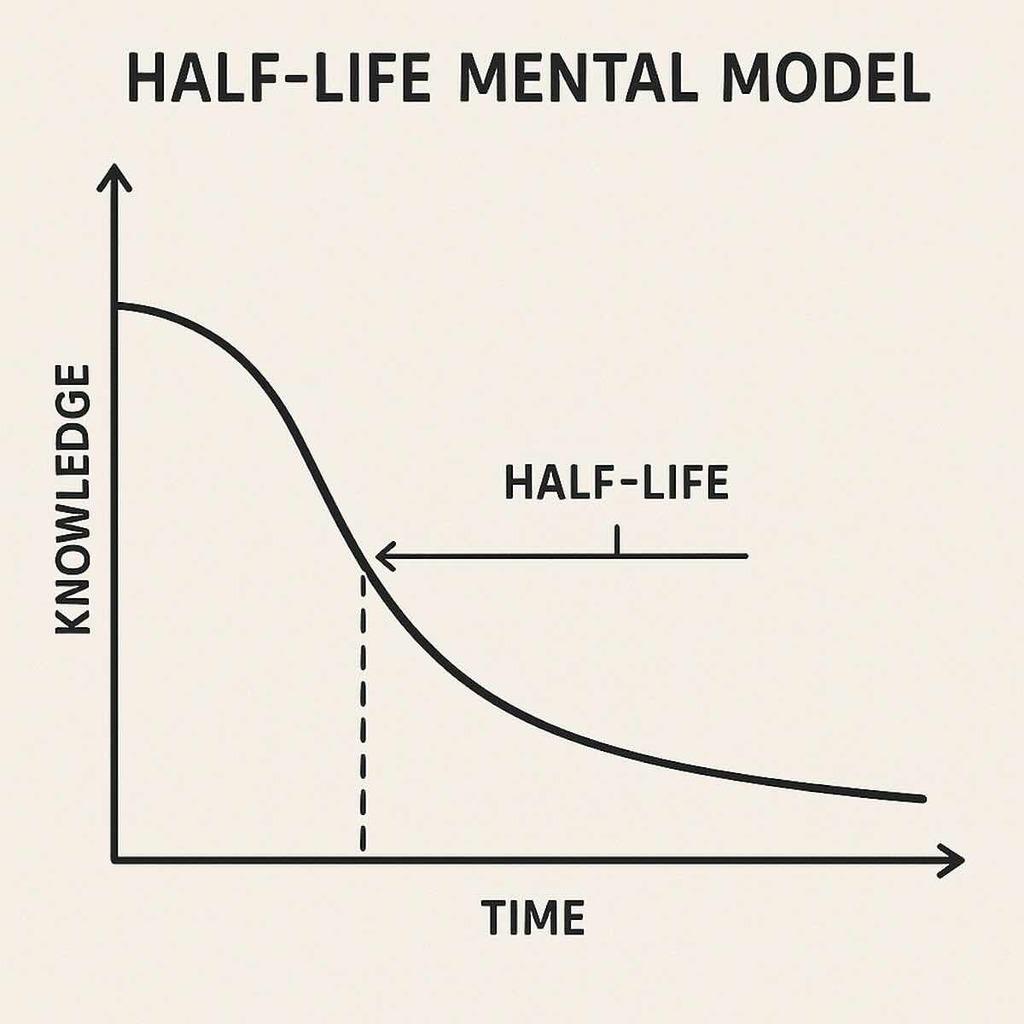Some facts stay useful for years, while others lose value in months. This model highlights the challenge of keeping up in tech fields. It shows why lifelong learning is essential.
It guides you in making better choices about what to learn and what to ignore. Whether in your career, business, or staying informed, it simplifies complex issues.
Understanding the Half Life Mental Model
The half-life concept applied to knowledge: value decreases predictably over time
A half-life is the time it takes for something to reduce to half its original value or quantity. While most commonly associated with radioactive decay in physics, this concept applies remarkably well to knowledge, skills, and information in our daily lives.
Just as uranium-235 has a physical half-life of 703.8 million years, the facts and information we learn have their own half-lives. Some knowledge remains relevant for decades, while other information becomes outdated in months or even days.
The key insight: Different types of knowledge decay at different rates, and understanding these rates helps us make better decisions about what to learn and when.
The Science Behind Half Lives
In physics, half-life describes how long it takes for half of the atoms in a radioactive substance to decay. This process is random at the individual atom level but becomes predictable when looking at large numbers of atoms.
Similarly, while we can’t predict exactly when a specific piece of information will become outdated, we can observe patterns in how different categories of knowledge tend to decay over time.
Samuel Arbesman, in his book “The Half-Life of Facts,” explains that information has a predictable half-life: the time taken for half of it to be replaced or disproved. As our tools and knowledge advance, we continually discover new information that sometimes contradicts what we previously believed to be true. See him here at TEDxKC.
“Every day that we read the news we have the possibility of being confronted with a fact about our world that is wildly different from what we thought we knew.”
The Half Life of Knowledge
Different fields of knowledge have dramatically different half-lives:
| Field | Approximate Half-Life | Implications |
| Medicine | 45 years | Medical professionals must continuously update their knowledge |
| Physics | 55 years | Core principles remain stable longer than applications |
| Engineering | 10 years (and shrinking) | Engineers need constant retraining to remain relevant |
| Technology | 1-2 years | Tech skills require nearly continuous updating |
| Social Media Tactics | 6 months | What works today may fail completely next year |
Understanding these half-lives helps us prioritize what to learn and how deeply to invest in different types of knowledge.
The Chromosome Example
A striking example of knowledge decay comes from human biology. Until 1956, medical textbooks taught that humans had 48 chromosomes. Two researchers, Joe Hin Tjio and Albert Levan, discovered the actual number was 46.
Many scientists had previously counted 46 chromosomes but assumed they were making errors since the “established fact” was 48. This illustrates how even “settled science” can be overturned, and how clinging to outdated information can impede progress.
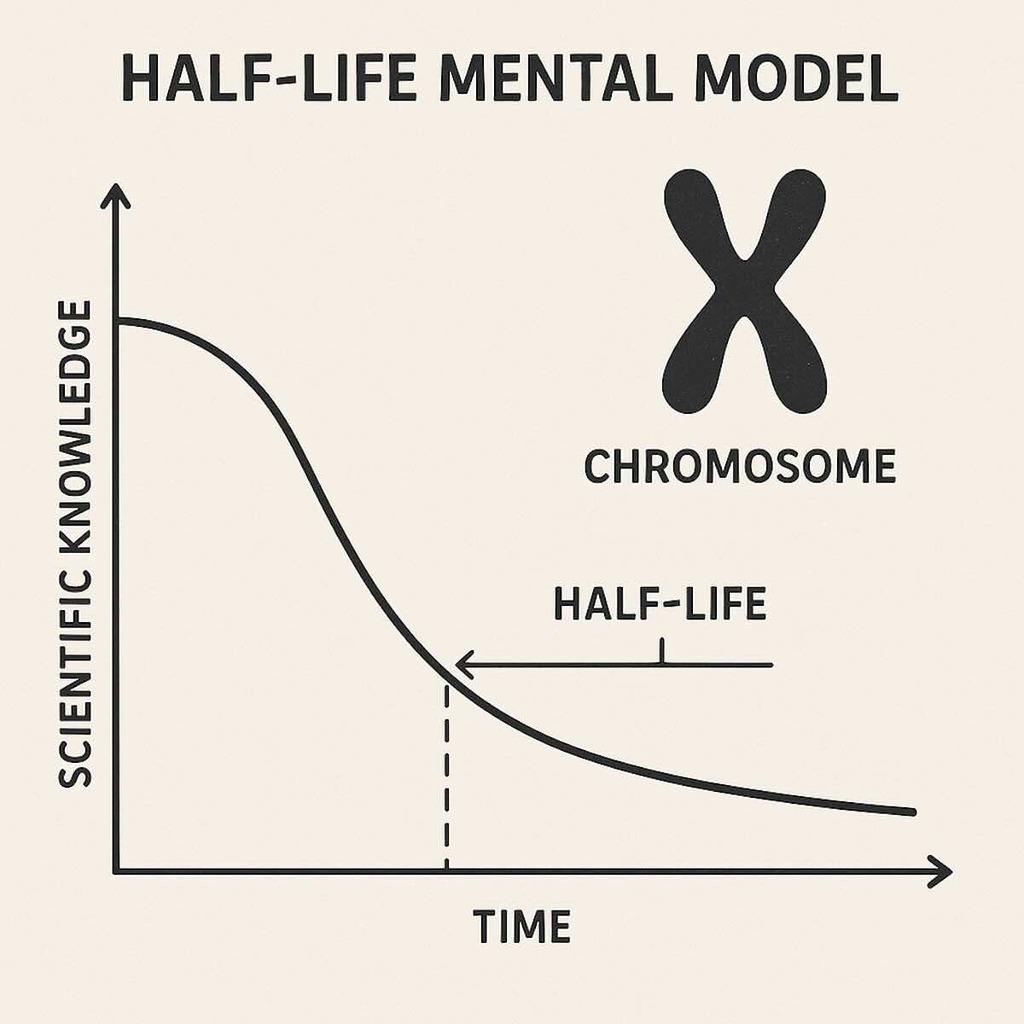
The evolution of scientific knowledge: How the accepted chromosome count changed
Real-World Applications of the Half Life Mental Model
Understanding half-lives helps us make better decisions in various aspects of life. Here are some practical applications:
1. Career Planning in a Changing World
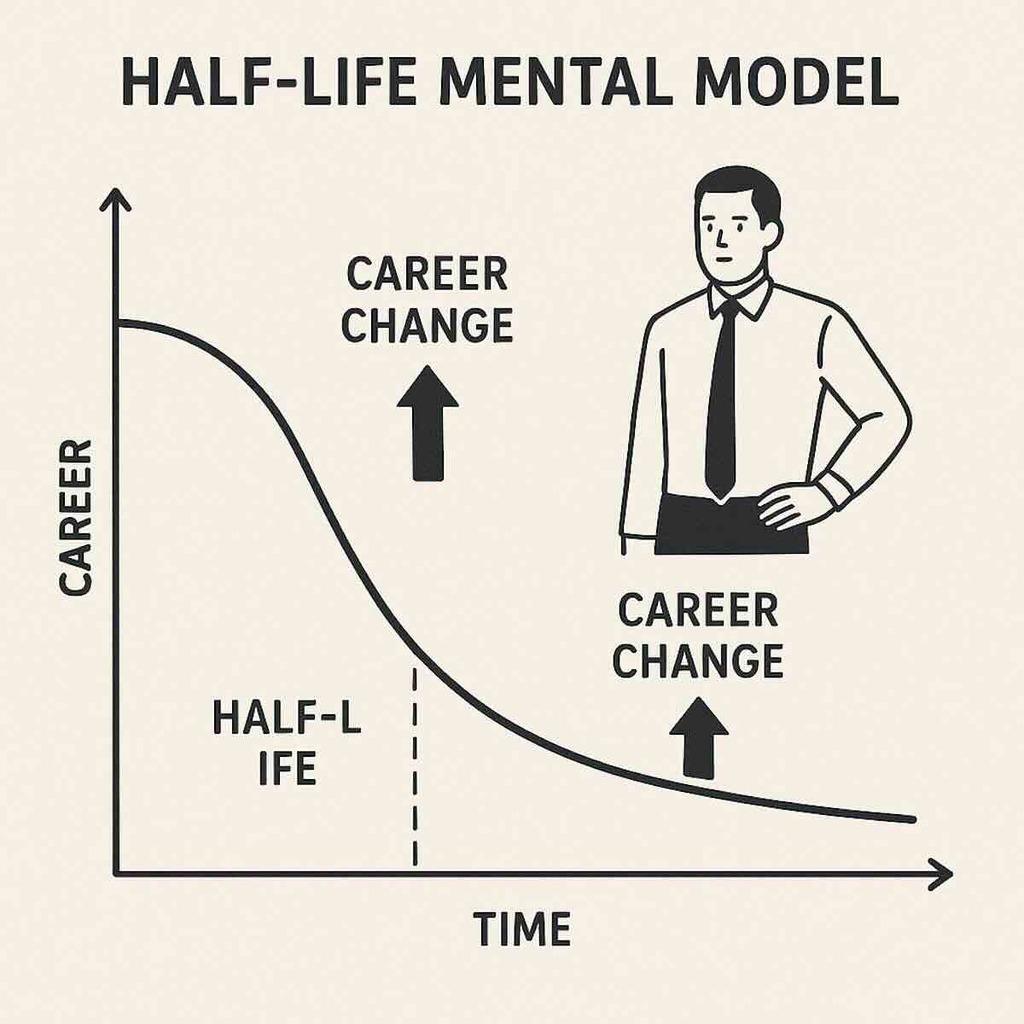
Adapting career strategies based on knowledge half-lives
A century ago, an engineering degree would remain relevant for about 35 years – half of what was learned would still be applicable. By the 1960s, that half-life had shrunk to just 10 years. Today, some estimate it’s between 2.5 and 5 years.
This rapid decay means engineers must devote significant time – between 10 and 20 hours weekly – just to stay current. This explains why tech companies often have younger workforces and why continuous learning is no longer optional but essential.
Career strategy: Focus on fields where you can build upon fundamentals that change slowly, while developing the meta-skill of rapid learning for areas that evolve quickly.
2. Technology Adoption Decisions
When deciding which technologies to invest time in learning, consider their likely half-lives. Programming languages like COBOL have proven remarkably durable, while many trendy frameworks become obsolete quickly.
This doesn’t mean avoiding fast-changing technologies entirely, but rather being strategic about depth of investment. For technologies with short half-lives, learn the core concepts rather than every implementation detail.
Technology strategy: Invest deeply in foundational skills with long half-lives, while staying adaptable with technologies that change rapidly.
3. Information Diet Management
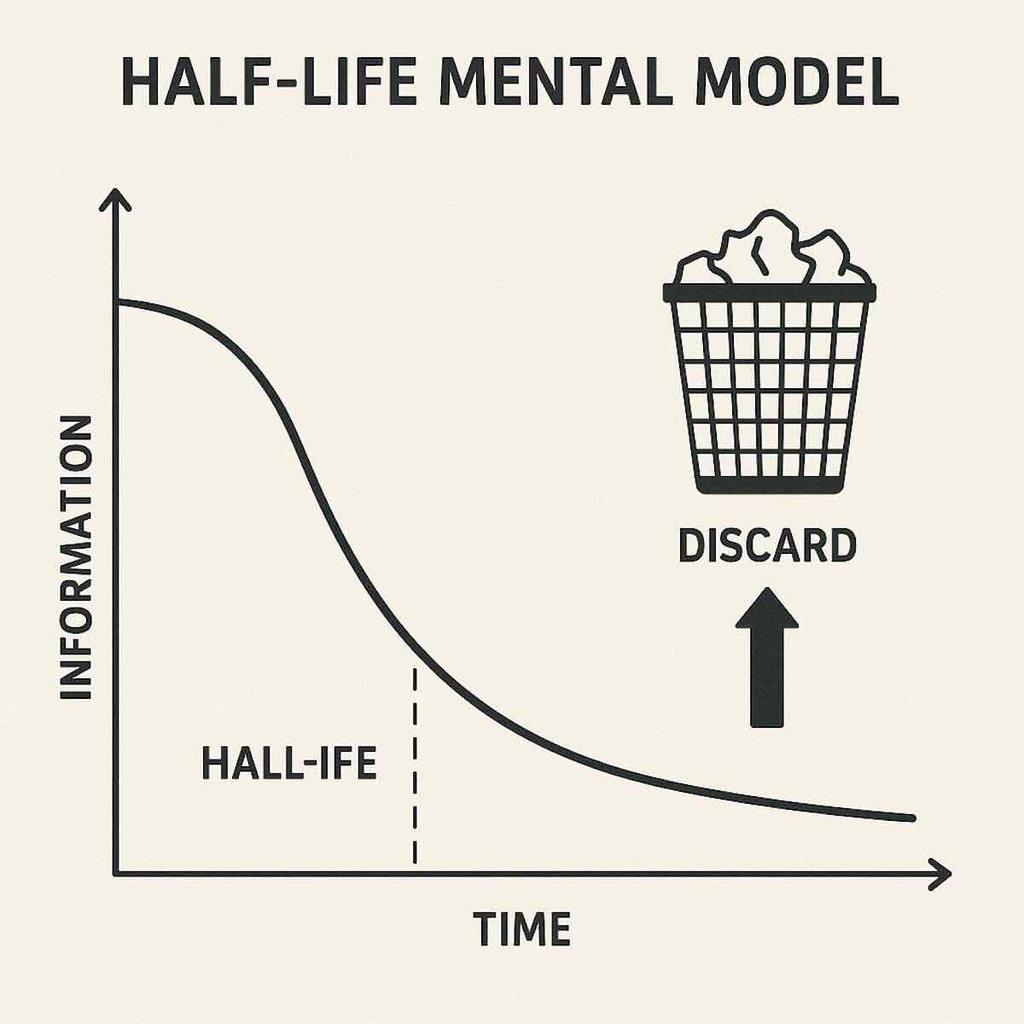
Balancing information consumption based on half-life value
Not all information deserves equal attention. News about current events typically has a very short half-life – it’s valuable briefly but quickly becomes irrelevant. By contrast, principles from fields like psychology, physics, or philosophy may remain useful for decades or centuries.
The half-life model suggests allocating your reading time proportionally to the half-life of the information. This might mean less time on news feeds and more time on books that have stood the test of time.
Information strategy: Prioritize information with longer half-lives, and be selective about consuming rapidly decaying information.
4. Business Model Innovation and the Half Life Mental Model
Business models themselves have half-lives. In the industrial era, a successful business model might last generations. Today, even dominant companies must continuously reinvent themselves as market conditions evolve rapidly.
As Saul Kaplan notes in “The Business Model Innovation Factory,” today’s business leaders are unlikely to manage a single business model for their entire careers. The ability to recognize when a business model is approaching the end of its useful life and pivot accordingly has become a crucial skill.
Business strategy: Build organizations capable of evolving their business models before existing ones become obsolete.
Visualizing the Half-Life Concept
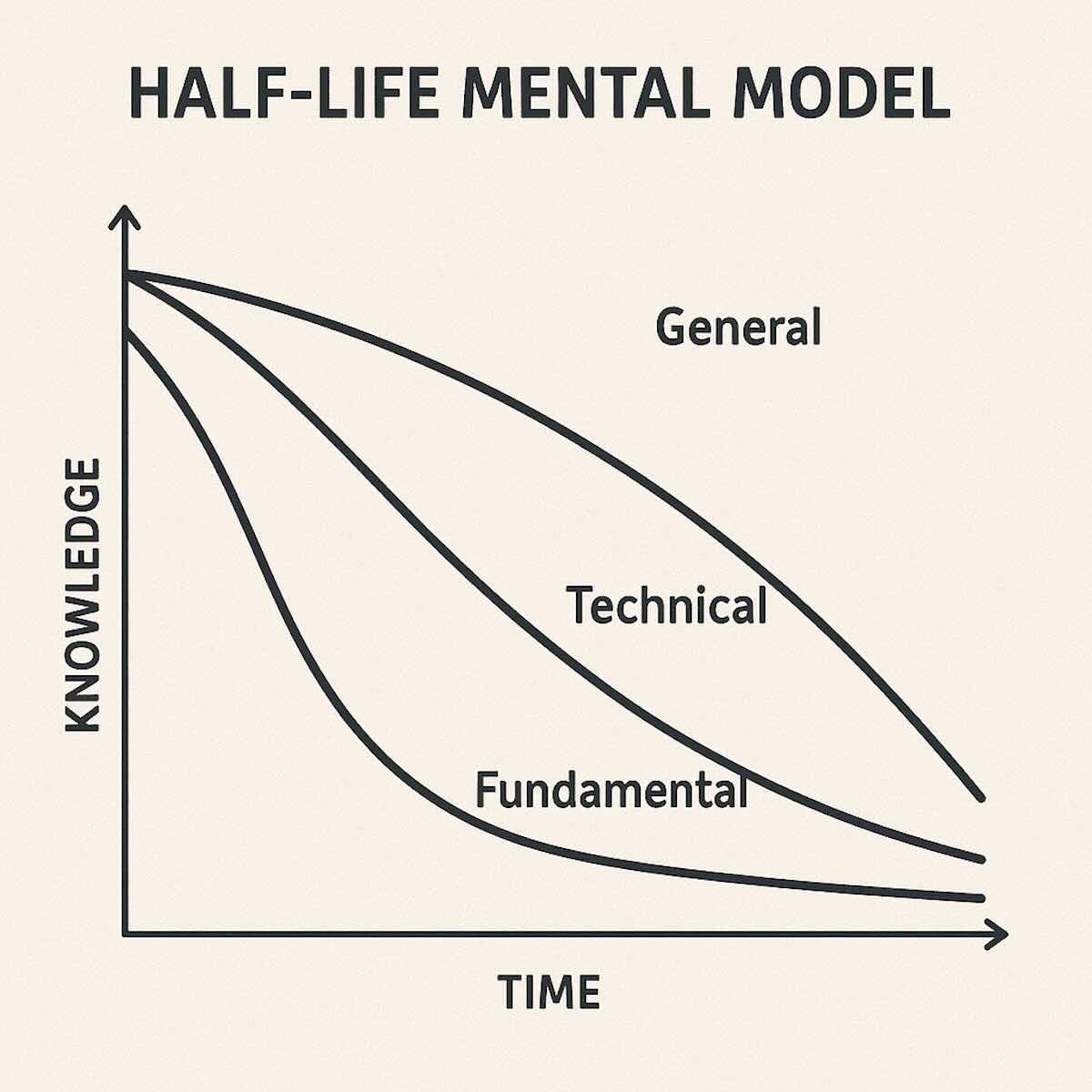
The Decay Curve
The half-life decay follows an exponential curve. After one half-life, 50% remains. After two half-lives, 25% remains. After three half-lives, 12.5% remains, and so on.
This pattern helps explain why staying at the cutting edge of rapidly changing fields requires exponentially more effort over time – you’re constantly racing against this decay curve.
The Flip Side: Knowledge Doubling
While knowledge decays, the total amount of human knowledge is simultaneously expanding. Buckminster Fuller observed that human knowledge doubled approximately every century until 1900, but by the end of World War II, it was doubling every 25 years.
Today, IBM estimates that human knowledge is doubling roughly every 12 hours, creating what Arbesman calls “the burden of knowledge.”
5 Ways to Apply the Half-Life Mental Model Daily
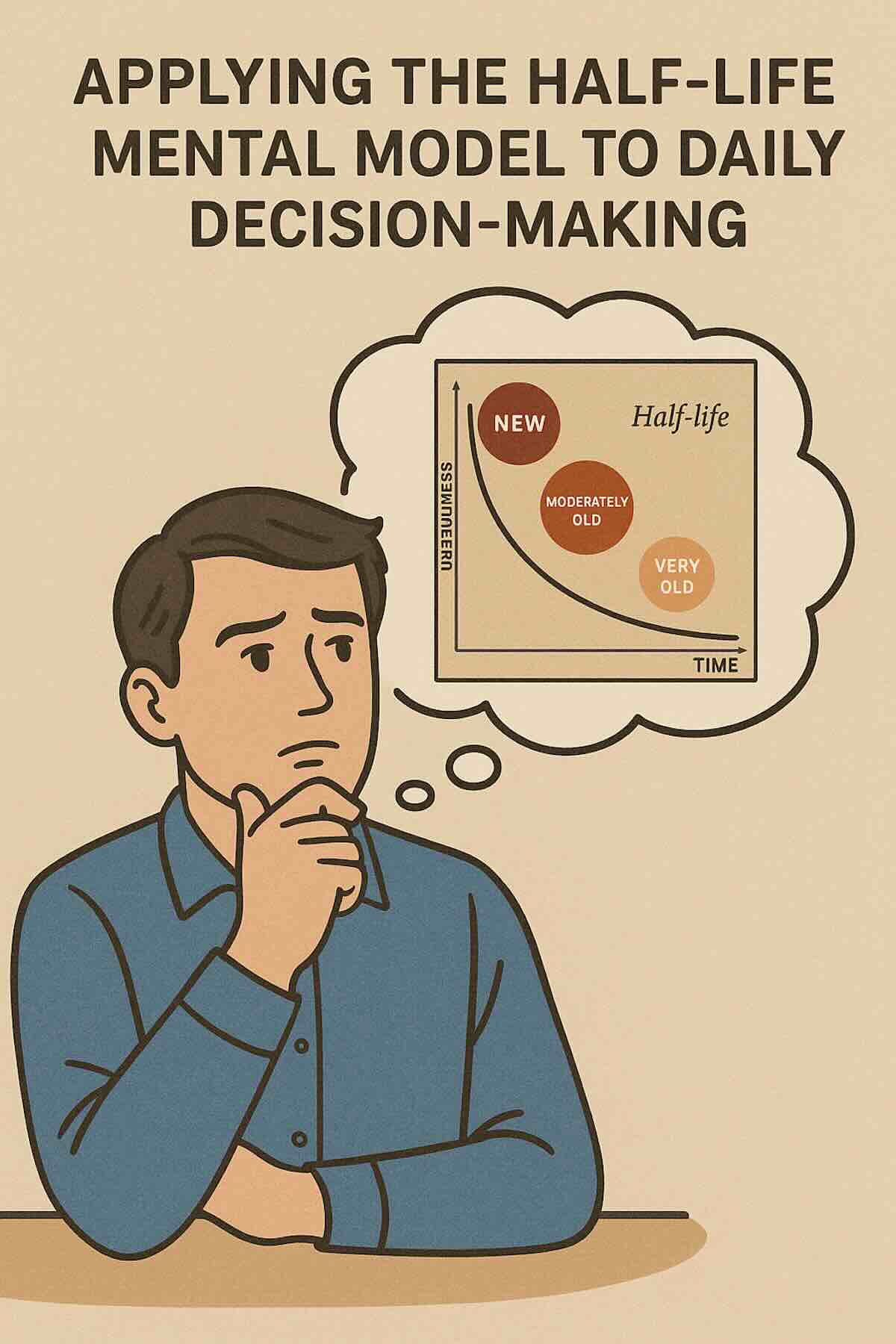
1. Audit Your Knowledge Portfolio
Regularly assess what you know and categorize it by estimated half-life. Identify areas where your knowledge may be outdated and prioritize updating those areas first. Just as financial investors diversify across different asset classes, diversify your knowledge across different half-life categories.
2. Develop Learning Systems, Not Just Goals
Instead of setting specific knowledge targets, create systems that continuously update your understanding. Subscribe to journals in your field, join communities of practice, and schedule regular learning reviews. The faster the pace of knowledge change, the more valuable the skill of learning becomes.
3. Focus on Principles Over Facts
When learning something new, prioritize understanding the underlying principles rather than memorizing specific facts. Principles have longer half-lives than individual facts and provide frameworks for assimilating new information. Mental models themselves are principles with long half-lives that help you organize and apply shorter-lived information.
Note: This idea is closely linked to First Principles Thinking. It means not relying on old assumptions or trends. Instead, you focus on the basic truths of something. This method has a lasting impact in science and strategy.
4. Practice Idea Triage
When consuming information, ask: “What’s the half-life of this information?” This helps prioritize what deserves deep attention versus what can be skimmed or ignored. Not all information deserves equal space in your mind – allocate attention based on long-term value.
5. Build Antifragile Skills
Develop skills that actually benefit from volatility and change. Writing, critical thinking, communication, and learning how to learn are examples of antifragile skills that increase in value as the world changes. The most valuable skills in a rapidly changing environment are those that help you adapt to change itself.
Note: Antifragile skills are closely tied to the concept of Optionality. The more adaptable your skills, the more choices you have in different situations. This flexibility allows you to thrive in uncertain environments.
Half-Life Examples Across Domains
Knowledge
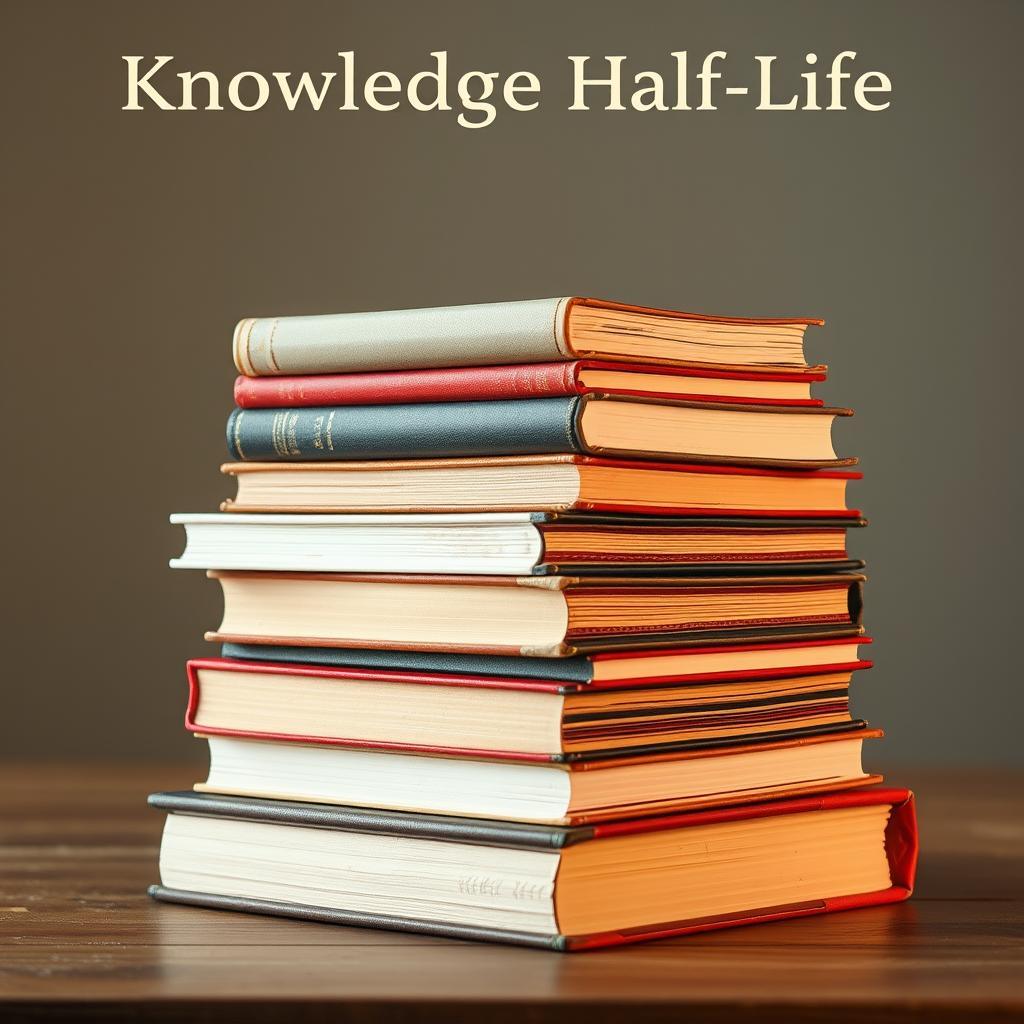
Academic papers in medicine: 2-3 years
Software development practices: 5 years
Fundamental physics principles: 50+ years
Marketing

Social media post: 20 minutes
Email campaign: 3-4 days
Print catalog: 3 weeks
Technology
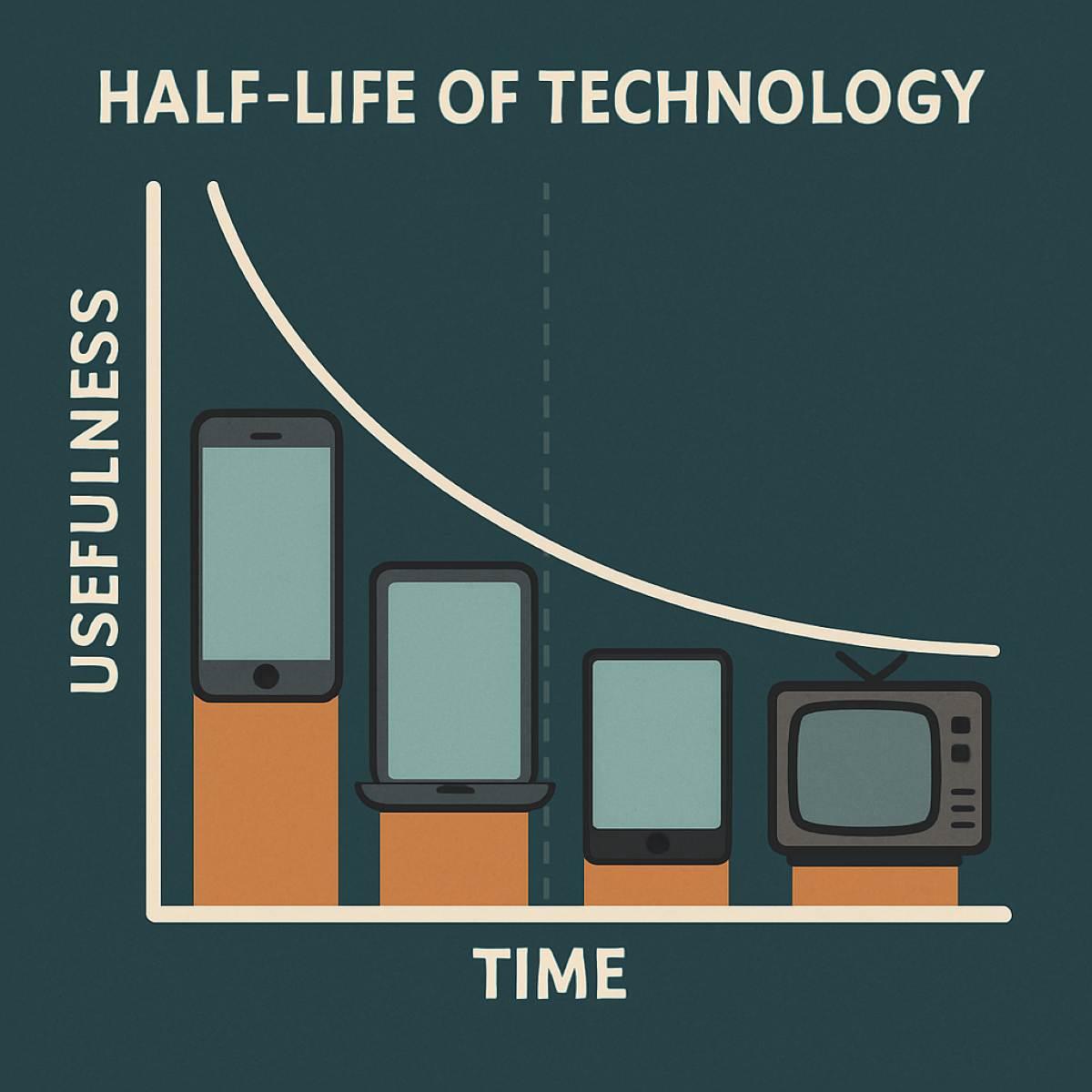
Smartphone model: 1 year
Programming language: 10+ years
Internet protocols: 20+ years
Challenges of the Half-Life Mental Model
Strengths
- Provides a framework for prioritizing learning
- Helps identify which knowledge to update first
- Encourages continuous learning mindset
- Explains why specialization increases over time
- Offers predictive power about knowledge value
Limitations
- Difficult to precisely determine half-lives
- Some knowledge doesn’t decay linearly
- Can lead to short-term thinking if misapplied
- May undervalue seemingly obsolete knowledge that could become relevant again
- Requires regular reassessment as conditions change

Balancing timeless principles with rapidly evolving information
While the half-life model is a powerful system, it’s important to recognize its limitations. Not all knowledge decays at a predictable rate, and sometimes seemingly obsolete information becomes relevant again in new ways and contexts for people and things.
The key is using the half-life model as one tool among many for navigating our information-rich world, not as the only framework for decision-making.
Mental Models with Long Half-Lives
Some mental models last a long time because they’re based on true principles. These models are useful across different fields and stay relevant even when things change.
Examples include:
- First Principles Thinking – Breaks ideas down to the basics.
- Second-Order Thinking – Considers long-term consequences.
- Opportunity Cost – Helps weigh what you give up in every decision.
These ideas don’t go out of date like software or marketing strategies do. They shape how we think, not just what we think about.
By focusing on these lasting models, you build mental “infrastructure” that endures. This makes it easier to adjust when new information comes along.
The Burden of Knowledge
As knowledge expands exponentially, the “burden of knowledge” increases. To reach the frontier of any field requires absorbing more and more prerequisite knowledge, which is a crucial way to enhance one’s research capabilities in their job.
The half life mental model highlights the importance of continuous learning and adaptation. This explains several modern phenomena:
Increasing Specialization
As fields expand, individuals must specialize in narrower areas to maintain expertise. This specialization allows deeper knowledge but can create silos and communication challenges between specialists.
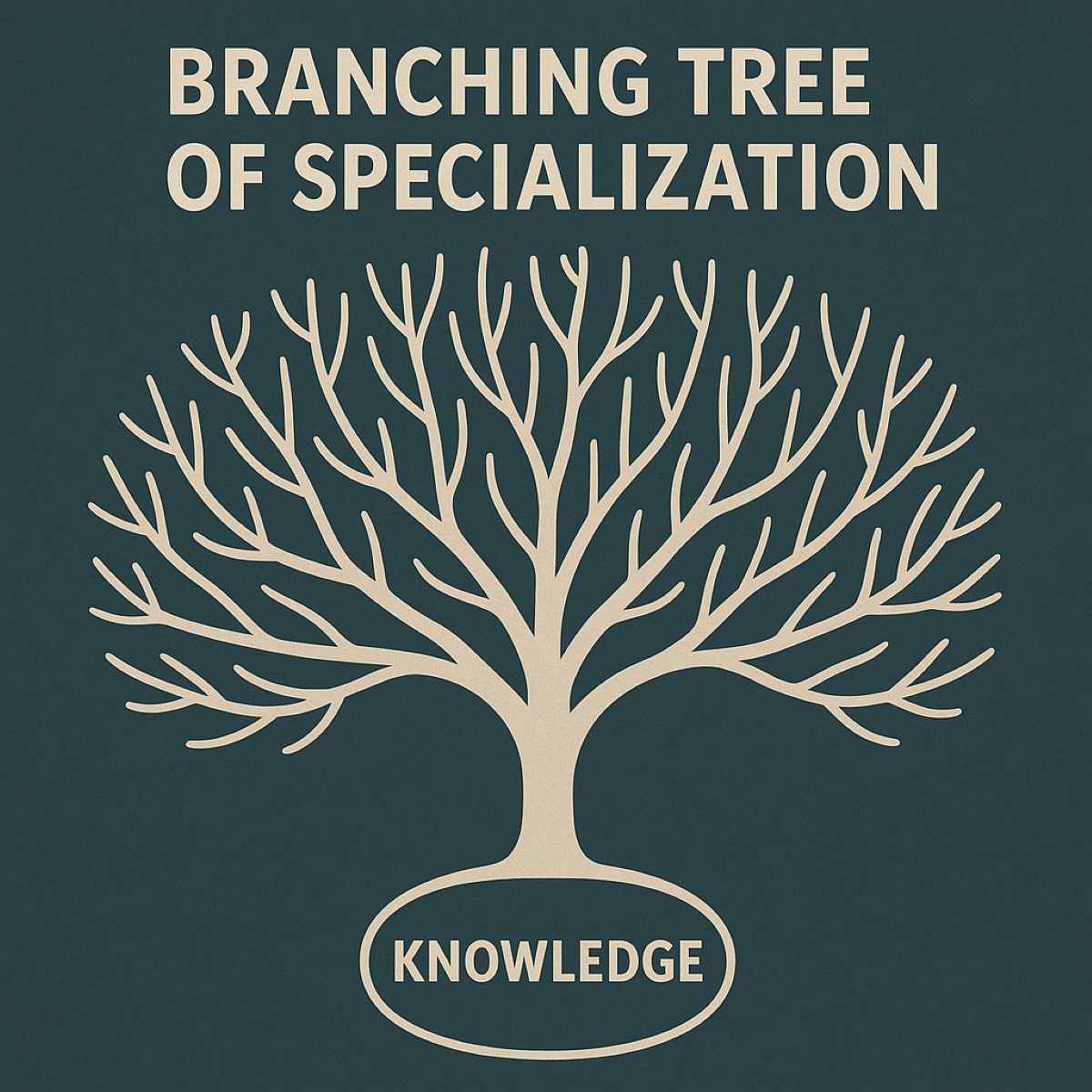
Collaborative Innovation
As individual mastery of entire fields becomes impossible, innovation increasingly happens through collaboration. Teams with diverse specialties can collectively navigate the expanding knowledge landscape.

Collaborative innovation addressing knowledge complexity
The half-life model suggests that as knowledge expands, the ability to integrate insights across domains becomes increasingly valuable.
Conclusion: Embracing the Half-Life Perspective

Strategic navigation through our changing knowledge landscape
Understanding the half-life of knowledge transforms how we approach learning and decision-making. In a world where information both expands and decays at accelerating rates, the ability to discern which knowledge to invest in deeply and which to hold lightly becomes crucial.
The most valuable approach combines:
- Building a foundation of principles and mental models with long half-lives
- Developing systems for continuous learning and knowledge updating
- Cultivating the meta-skill of learning how to learn
- Balancing specialization with cross-domain integration
By viewing knowledge through the lens of half-lives, we can make more strategic decisions about where to invest our most precious resource: our attention.
The half life mental model teaches us that knowledge has a shelf life. It guides us in managing what we learn and how long it remains relevant. This model helps us decide what to study and where to focus our efforts.
You don’t have to remember everything. Just know what’s fleeting, what’s lasting, and how to refresh your knowledge. Pair this with other lasting mental models, and you’ll have a versatile toolkit that adapts to change.
